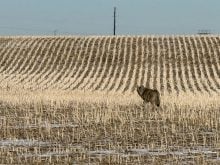Alberta scientists have been studying something many llama owners have known for years – llamas are more than beasts of burden and guard animals.
“Quietly people have been eating them,” said Shelley Bevans, a llama owner and the push behind a llama meat quality study.
“People do like them, but it has to be out in the open,” said Bevans of Blackfalds, Alta.
It is time to explore the meat market, she said, because the demand for farm llamas used for guard animals and breeding stock has fallen off, as have the animals’ price tags.
Read Also

Agritechnica Day 2: The future of tractor power, building quicker crop apps and large farms and tech
Agritechnica Day 2: The future of tractor power, building quicker crop apps with Syngenta and large farms and tech
“People are just collecting them. They’re adding up in the field,” said Bevans, who has 140 llamas at her central Alberta farm.
“Some people give them away. We refuse to sell anything for under $500. That’s why we have so many.”
During the study at the Agriculture Canada research facility in Lacombe, scientists butchered 12 two- and three-year-old llamas to gain basic information on carcass and meat quality.
The scientists also tested the efficacy of aging and high voltage electrical stimulation in reducing variability in meat tenderness.
Llama carcasses, like other specialty meats such as deer and elk, have little covering fat. That allows the carcass to cool quickly, but reduces meat tenderness, said the report.
It recommended that high voltage electrical stimulation of the carcass, combined with aging, be used to improve tenderness.
The report also said llama meat has a low fat content and higher protein content than beef.
Bevans said this information, combined with cholesterol tests they plan to conduct, will give llama owners the information they require to start selling llama as a specialty meat.
“It would be an exotic meat comparable to buffalo or ostrich.”
But like all alternative meat industries, it takes money to do the tests and develop the markets.
Pulling the money together is not easy, said Bevans, who is busy writing research proposals to fund more research.
“Funding is always a problem. Everything costs money to start.”
Bevans hopes the development of a meat market will result in more animals being culled and a gradual increase in the price of llamas.
People who sample the meat seem to like it, but Bevans is not sure if that interest would translate into sales. Some people say llama tastes similar to beef.
“We give people samples but I don’t know, if push came to shove, whether they would buy it,” she said.
“It’s like beating your head against the wall, then you back up and do it again.”














